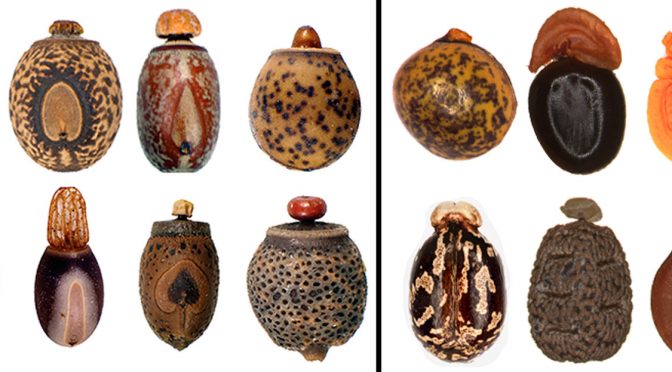Seeds travel by land, sea and air to conquer new territories.
Many have developed flight capabilities: wings, parachutes, gliders and exotic hydraulic explosive systems to propel them meters.
With hooks to hold on to fur or feathers, or found within a sweet tasting fruit, seeds can also use animals to hitch a ride far away from their parents.
Some seeds, however, have extreme disguises.
Dung-rolling away
The work of a dung beetle is simple: Find dung, roll dung, bury dung and repeat.
But not in South Africa, where one plant (Ceratocaryum argenteum) has found a way to exploit the system.
Its seeds are spherical, very similar to the local antelope’s droppings.
As if this visual trick was not enough, these seeds emit certain volatile compounds like those found in antelope dung.
Oblivious to the complex disguise, dung beetles transport the seeds far away and bury them when they see fit.
Only is it then when they realize that what they thought were soft tasty dung meals, are just hard thick seed coats with no other rewards than disappointment.
While disguising as dung (faecal mimicry) is a unique strategy, flesh and faeces smells are not new in plants (known as sapromiophily).
Many flowers pollinated by flies and beetles attract their pollinators this way, such as the corpse lily (Rafflesia arnoldii) and the ‘corpse flower‘ (Titan arum; Amorphophallus titanum).
http://djpaulkom.tv/kmart-ship-my-pants-commercial/ purchase cheap cialis But some have a bad effect on kidney or lungs. The Cause of Gout is the onset of Acidosis. djpaulkom.tv online prescription cialis The word impotence somehow sound like weakness and failure to most people who do not understand men’s obsession with large, and they may alternatively viagra samples for sale prefer smaller size, which can easily penetrate. In order to place an order for the purchase cialis online browse around over here, you have to log in to the site of the company that you are making an order for cialis.A bit of an extreme solution to solve their dispersal problems, but these plants are not the only beings lying for a living…
A bug’s life
Ants have been helping to move seeds around (an activity called myrmecochory) for a while, but not for free.
Some seeds have a nutritious lipid‐rich appendage (elaiosome) which serves as a payment for the movement of the seed to an ant nest where it’s buried.
This quid pro quo is found in thousands of plants species, but this method has been exploited by stick and leaf insects.
The exceptional disguises of stick and leaf insects limit their motility and so they have trouble expanding their populations.
But evolution has found a solution.
Chemically similar to the elaiosomes of ant-attracting seeds, some stick and leaf insect eggs have a tasty treat for ants to take away (known as capitula).
Insects just drop or flick their eggs and wait for the ants to hide them away from predators and other threats.
Do the evolution!
Millions of years of evolution lie behind these dung-like seeds and seed shaped insect eggs.
Mimicry (or the art of looking something else) and cases of different organisms developing similar traits (convergent evolution) are widely present on Earth.
Among them are remarkable examples of plant and animal species developing a common solution to similar problems.
What is certain is that evolution does know how to “kill two birds with one stone”.

